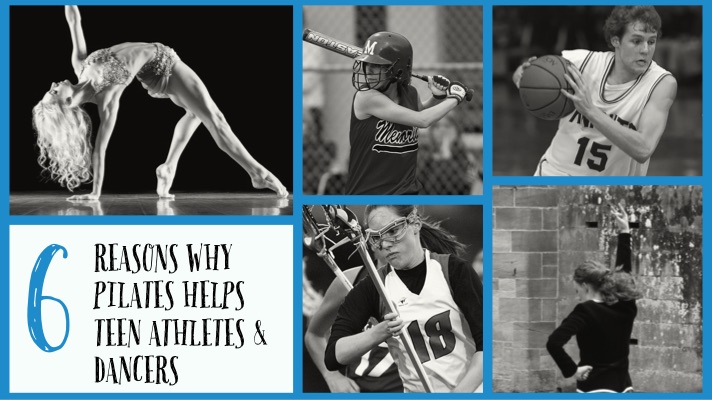
I often talk about how important cross-training is, and I believe the same is true for kids and teens. When just one sport takes up several days a week, or even runs year-round, cross-training becomes more difficult. Some children can only focus on one sport – due to time, money, or their interests. So why try and add another day of activity?
Pilates helps teen athletes and dancers especially, because it works the body as a whole. Compare this to one-sided throwing, jumping, or even skating where you push off with the same foot each time. Focusing only on one sport can lead to overuse injuries, muscular imbalances, and fatigue; Pilates can help prevent injuries, correct imbalances, and even improve their performance in their chosen sport.
6 Reasons Teen Athletes & Dancers Should Try Pilates
1. Foundational Strength – If a home is built on a weak or broken foundation, the home will quickly become weak too. Pilates is very well known for helping to build core strength. This is true, but Pilates is more than core. Pilates strengthens your glutes, back, arms, legs, ankles, neck, and even your lungs. All of the smaller, stabilizing muscles will also be developed. For example, if their hip, glute, and ankle muscles are stronger, they are less likely to sprain an ankle. Or when they get pushed or knocked during sports play, your child’s foundational muscle strength will help them avoid falling over.
2. Body Awareness & Control – Pilates is a very mindful method of movement. It focuses on moving your limbs from your trunk and core – often referred to as “the powerhouse” in Pilates. Think about throwing a ball or shooting a puck; if your child is doing this motion with only their arms, there is much more chance of tendon strain, or pain in the elbows, shoulders, or wrists. However, if you are using your full body to rotate with the motion of the arms, they will have more control, power, and do the motion with less effort and potential for injury.
3. Uniform Strength – Repetitive movements and over-use will cause muscular imbalances in the body. We will always have a more dominant side, and are unlikely to start practicing sports using our non-dominant side. But if we can even out the stronger and weaker muscles, it will be helpful in avoiding unnecessary aches and pains.
In some sports our children may become very strong in one area of the body over another. Hockey players have leg strength, dancers are more flexible, and baseball players have strong shoulders. Pilates helps teen athletes to work on both symmetrical and asymmetrical movements. It is about teaching your muscles to move together with control as well as independently. For example, in a squat your stronger leg will help the weaker leg. When we take the squat to a single leg, each leg has to work on its own.
4. Posture – Children spend a lot of time slouching due to technology, they sit a lot of the day at school, and they can develop postural imbalances due to their sports or musical instruments. In general, this means tightness in the front sides of their bodies (chest, hip flexors). Tightness means weakness. Pilates focuses a lot on strengthening the back side of the body, which in turn relieves front-side tightness.
5. Flexibility & Mobility – Flexibility and mobility are often confused as being the same thing. They are very different but do go hand-in-hand, and Pilates works on both. Flexibility is the ability of a muscle to lengthen, while mobility is the ability of a joint to move. Each Pilates exercise takes strengthening, stretching, and mobility into consideration.
Repetitive movements and over-training can cause a build-up of lactic acid and tight muscles, making your child’s muscles feel sore and fatigued. Proper whole-body stretching will help your child become more flexible, which will help reduce the achiness.
Joint mobility helps your child to move with more power and efficiency, improving athletic performance as well as helping to improve posture, reduce chances of injury and general aches and pains.
6. Balance – In all sports, your balance is important. It is most obvious in dance or gymnastics, but any time you are on one leg, splitting your stance, or using equipment, you need to use your stabilizing muscles. In Pilates, we work on balance in a variety of positions, using body weight and apparatus to change things up. Working on balance is yet another way cross-training can help teen athletes improve their form and prevent injuries.
Kids are very good at hyper-focusing on one thing, or one sport. It is important to teach them now to take care of their bodies – and cross-training is one of those ways. Through working their whole body, they can prevent injury, get stronger, and increase their performance. Pilates helps teen athletes become more well rounded physically. This means they’ll feel and do better now; and when they decide to give another sport or position a try, their bodies will be ready to support them.
Check the schedule to see what teen classes (Pila-Teens) are available, or book a duo session with your teen, and workout together.